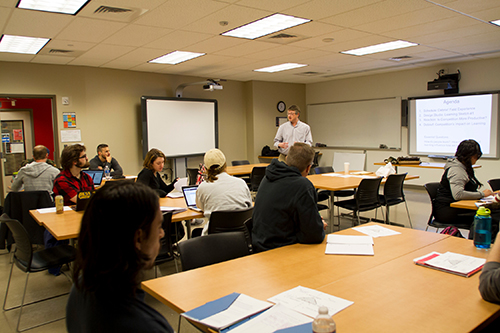April
Thirsty for a Strong Instructional Practice?
SIP 6.12: The Difference Between “Methodological Variety” and “Universal Design for Learning”
April 12, 2018
 SIP 6.12: The Difference Between “Methodological Variety” and “Universal Design for Learning”
SIP 6.12: The Difference Between “Methodological Variety” and “Universal Design for Learning”
Two professors were overheard chatting about their classes:
Professor A: This semester, I am really doing a lot in my classes. Over the course of the semester, all of my students do paired work, group presentations, individual projects and other fun activities in and out of class.
Professor B: Cool! This semester, I am using Universal Design for Learning.
Professor A: Isn’t that the same as what I just described?
In fact, methodological variety does not necessarily constitute Universal Design for Learning. UDL is a set of principles that go beyond methodological variety in that its purpose is to make material and concepts accessible to the widest population. UDL seeks to make accommodations for individual students obsolete by incorporating accessibility into the very design of the curriculum and the methods used to teach and learn content.
Try this: The Difference Between “Methodological Variety” and “Universal Design for Learning”
Planning a course using UDL requires in-depth consideration of the needs of the many learners who enter your class. As Mark Emmert writes in the foreword to Burgstahler and Cory’s Universal Design in Higher Education (2008), “Instead of creating courses, services, information technology, and physical spaces for the ‘typical’ student and then making modifications for students for whom they are inaccessible, this approach pro-actively addresses the needs of people with the broadest range of characteristics during the design process. This approach leads to educational products and environments that are welcoming, accessible, and inclusive and that address all aspects of diversity, including disability.”
So how can we use UDL to design and teach our courses? Here are a few tips:
- Remember that the goal of UDL is to allow access, but this does not mean to lower your standards. Always start with your course-learning outcomes and build around those while allowing UDL to guide you.
- Take a minute to think back on some of the challenges that students have had in your courses. In particular, think about students who have approached you requesting accommodations. As you design your course, incorporate those accommodations into the design, thereby eradicating the need for students to request them. For example, incorporating class note-taking into the design of your course makes it unnecessary for students to ask for this common accommodation. See SIP 1.1, “The Class Notetaker,” for more on this.
- Curriculum, classroom activities and assessment that adhere to the philosophy of UDL are underpinned by the following three premises:
- Multiple means of representation: Faculty members teaching with UDL should always be conscious of representing each aspect of their course content in a variety of modalities that allow all students to access it. For example, cover the same content in many ways: in-class lecture, out-of-class reading, subtitled video, kinesthetic and/or practical application of learning by doing. If all representations are made available to everyone in your class, students can pick and choose the method that best serves their needs to learn what you are teaching. See SIP 1.9, “Beyond the Lecture,” for more on this.
- Multiple means of engagement: Provide students with a variety of opportunities to manipulate the course content. For example, you may let students work in groups, work alone, do some writing, create a video, embed the material in a script for a play, etc. Allowing students a diversity of engagement will let them bring their own interests and skills to the table and make the learning more meaningful and long-lasting. See SIP 2.23, “Differentiated Assignments,” or SIP 2.16, “Assignment Menus,” for more on this.
- Multiple means of expression: Create different ways of assessing mastery of course content. Not everyone does well on an exam, a written paper or an oral presentation; provide students with multiple avenues of demonstrating that they are meeting the learning outcomes of your course. See SIP 2.24, “Universally Designed ‘Value Rubrics,’” for more on this.
Always keep these three ideas in mind while writing your syllabus, designing your curriculum and implementing class activities.
Still Thirsty? Take another SIP of The Difference Between “Methodological Variety” and “Universal Design for Learning”
Burgstahler, S. and Cory, R. (2008). Universal Design in Higher Education. Boston: Harvard Education Press.
Check out the CAST website. CAST connects the neuroscience of learning to UDL practices to help faculty create curriculum and methods that promote student success.
CAST has a fabulous resource that offers tips and tricks for designing courses for higher ed by using UDL: UDL On Campus. You can really find everything you need to get going there.
There are many SIPs that touch on Universal Design. Visit The Well to read them all.
The MSU Denver Access Center has great information on UDL on its website. Check it out to learn about designing your course with UDL. The Access Center also hosts an annual award to recognize faculty excellence in teaching with UDL. Check out the list of past winners and ask them about their work.
Visit The Well at http://sites.msudenver.edu/sips/ for more great ideas and resources for Strong Instructional Practices in your higher-education classroom.
